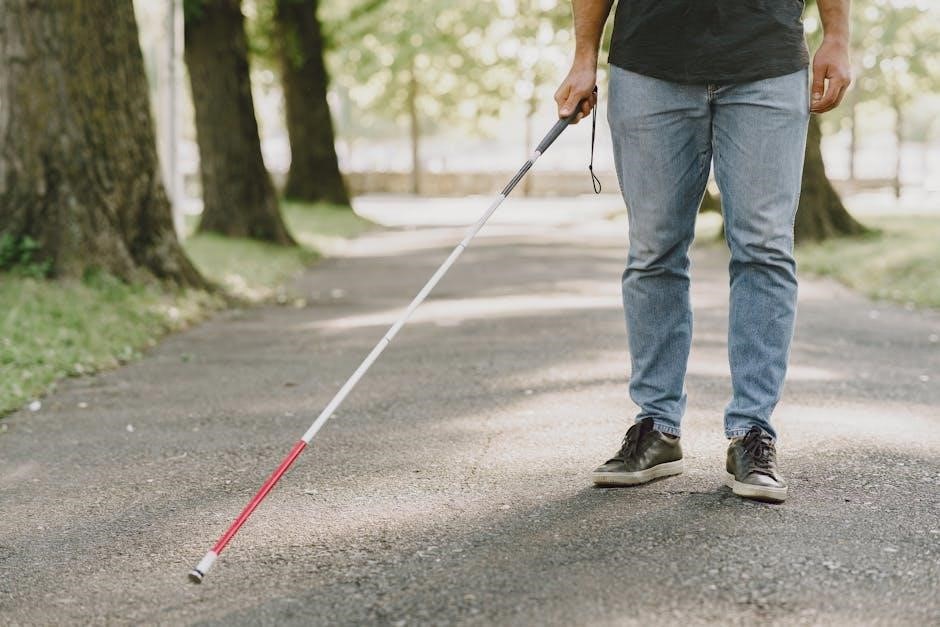The guide cane is assistive mobility tool used by visually impaired people to safely navigate surroundings with ease and confidence every day normally.
Definition and Purpose
A guide cane is defined as a long white stick used by visually impaired people to navigate surroundings, the purpose is to provide information about the environment, it extends from the floor to the user’s waist, allowing them to scan for obstacles, kerbs and steps, and identify doorways, the guide cane is used to detect variations in ground level, it is an essential tool for safe and independent mobility, enabling users to move around with confidence, the definition and purpose of a guide cane are closely linked to its function as an assistive mobility aid, designed to facilitate navigation and orientation in various environments.
Types of Guide Canes
Guide canes have various types and styles available normally used.
Features and Uses
Guide canes have multiple features and uses, including detecting obstacles and variations in ground level, identifying doorways and steps, and providing protection. The cane can be used to scan for kerbs and steps, and can also be used diagonally across the body for protection, warning the user of obstacles immediately ahead. Additionally, the cane can be used to sweep or tap from side to side to get more information about the environment. The features and uses of guide canes make them a essential tool for visually impaired people to navigate their surroundings safely and confidently, and to maintain their independence and mobility.

Benefits of Using a Guide Cane
Guide canes provide safety and confidence to visually impaired people every day normally always.
Visual Impairment Safety
Visual impairment safety is a major concern for individuals with limited vision, and guide canes play a crucial role in addressing this issue. The white color of the cane is highly visible, making it easier for others to notice the user’s visual impairment. This increased visibility helps to prevent accidents and ensures a safer environment for the user. Additionally, the cane’s ability to detect obstacles and changes in terrain provides an extra layer of safety, allowing users to navigate their surroundings with confidence. By using a guide cane, individuals with visual impairments can reduce their risk of injury and feel more secure in their daily lives.

How to Choose a Guide Cane
Choosing a guide cane involves considering factors like length and material normally used.
Considerations and Factors
When selecting a guide cane, several considerations and factors come into play, including the user’s height, weight, and personal preferences. The cane’s length, material, and weight are also important factors to consider. Additionally, the type of tip and the cane’s overall durability should be taken into account. Some users may prefer a folding cane for ease of storage, while others may prefer a straight cane for its simplicity. The cane’s color and reflective properties may also be important for visibility and safety. By considering these factors, users can choose a guide cane that meets their individual needs and provides them with confidence and independence. The right cane can make a significant difference in a user’s daily life.

Proper Cane Techniques
Users master proper techniques to navigate surroundings with confidence and ease normally every day.
Grip and Stride Techniques
The grip and stride techniques are essential for using a guide cane effectively, allowing users to move with confidence and independence.
A proper grip and stride enable users to scan their surroundings and detect obstacles with ease, promoting safe navigation and mobility.
The techniques involve holding the cane correctly and moving it in a sweeping motion to gather information about the environment, which is crucial for visually impaired individuals.
By mastering these techniques, users can enhance their spatial awareness and navigate through various spaces with greater ease and confidence, ultimately improving their overall mobility and independence.
Advanced Cane Techniques
Expert users develop advanced cane techniques for enhanced mobility and spatial awareness skills naturally every day.
Diagonal and Two-Point Touch
Diagonal and two-point touch techniques are used for detecting obstacles and stairs, providing additional information about the surroundings. These techniques involve holding the cane diagonally across the body or using two points of contact with the ground to gather more detailed information about the environment. By using these techniques, users can improve their spatial awareness and mobility, allowing them to navigate complex spaces with greater ease and confidence. The diagonal technique is particularly useful for detecting low-hanging obstacles, while the two-point touch technique provides more detailed information about the terrain and potential hazards. Effective use of these techniques requires practice and training.
Comparison with Guide Dogs
Guide canes and dogs differ significantly in terms of training and obstacle avoidance methods used daily normally always.
Differences and Similarities
The guide cane and guide dog have distinct differences in their approach to navigation, with the cane relying on user input and the dog on training.
The guide dog is trained to avoid obstacles, while the cane user must interpret the environment through touch and sound, requiring different skills and techniques.
Both tools aim to provide independence and mobility, but their methods and user experiences vary significantly, with the cane offering a more tactile experience and the dog a more autonomous one, each with its own advantages and considerations to be taken into account when choosing between them, and understanding their differences and similarities is crucial for making an informed decision.

Maximizing Mobility and Independence
Expert guidance helps users master guide cane techniques for enhanced mobility and independence every day with confidence and ease normally always.
Expert Guidance and Proven Methods
Expert guidance is essential for mastering guide cane techniques, providing users with the skills and confidence to navigate their surroundings effectively. Proven methods, such as proper grip and stride techniques, can be learned through practice and training. With the right guidance, users can maximize their mobility and independence, overcoming obstacles and challenges with ease. By following expert advice and proven methods, guide cane users can improve their overall navigation skills, ensuring a safer and more confident experience. This expertise can be obtained through specialized training programs or workshops, where users can learn and practice guide cane techniques in a supportive environment, every day.
The guide cane provides essential support and navigation for visually impaired people every single day normally always.
Importance of Guide Canes
The importance of guide canes lies in their ability to provide independence and mobility to visually impaired individuals, enabling them to navigate safely and confidently. Guide canes play a crucial role in helping users to detect obstacles, avoid accidents, and move around with ease. They are an essential tool for daily living, allowing users to participate fully in their communities and engage in various activities. The use of guide canes has a significant impact on the quality of life of visually impaired individuals, promoting autonomy, self-reliance, and overall well-being. By using a guide cane, individuals can regain their confidence and independence.

